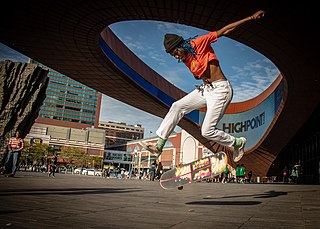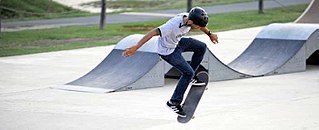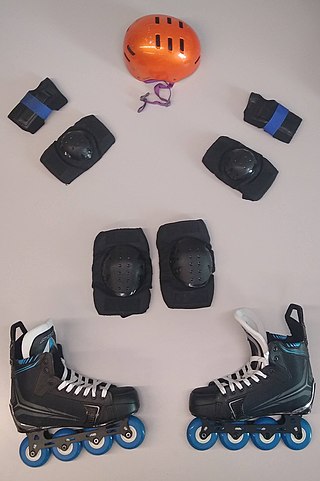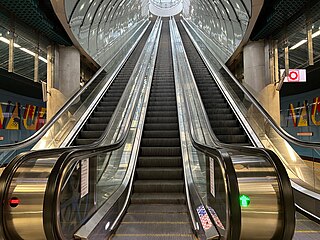
Skateboarding is an action sport that involves riding and performing tricks using a skateboard, as well as a recreational activity, an art form, an entertainment industry job, and a method of transportation. Originating in the United States, skateboarding has been shaped and influenced by many skateboarders throughout the years. A 2009 report found that the skateboarding market is worth an estimated $4.8 billion in annual revenue, with 11.08 million active skateboarders in the world. In 2016, it was announced that skateboarding would be represented at the 2020 Summer Olympics in Tokyo, for both male and female teams.

A skateboarding trick, or simply a trick, is a maneuver performed by manipulating a skateboard, usually with one's feet, in a specific way to achieve the desired outcome – the trick.

Inline skates are a type of roller skate used for inline skating. Unlike typical roller skates, which have two front and two rear wheels, inline skates typically have two to five wheels arranged in a single line. Some, especially those for recreation, have a rubber "stop" or "brake" block attached to the rear of one or occasionally both of the skates so that the skater can slow down or stop by leaning back on the foot with the brake skate.

A skatepark, or skate park, is a purpose-built recreational environment made for skateboarding, BMX, scootering, and aggressive inline skating. A skatepark may contain half-pipes, handrails, funboxes, vert ramps, stairsets, quarter pipes, ledges, spine transfers, pyramids, banked ramps, full pipes, pools, bowls, snake runs, and any number of other objects.

Roller skating is the act of travelling on surfaces with roller skates. It is a recreational activity, a sport, and a form of transportation. Roller rinks and skate parks are built for roller skating, though it also takes place on streets, sidewalks, and bike paths.

Chad Muska is an American professional skateboarder, musician and entrepreneur. In November 2012, Skin Phillips, editor-in-chief of Transworld Skateboarding, described Muska as "one of the most marketable pros skateboarding has ever seen."
Deluxe Distribution is an Ermico Enterprises, Inc.-owned skateboarding company founded in 1986 with limited partner Brian Ware in San Francisco. Deluxe was formed to distribute the Beware Record label, and other small record labels popular with skateboarders, along with Thunder Trucks and Supercush Bushings. Deluxe distributes six skateboard brands and owns DLXSF, a retail outlet.
Soap was the brand name of shoes made for grinding, similar to aggressive inline skating. They were introduced by Chris Morris of Artemis Innovations Inc. with the brand name "Soap" in 1996. They have a plastic concavity in the sole, which allows the wearer to grind on objects such as pipes, handrails and stone ledges. The company and its product rapidly gained popularity through fan sites, a video game and live demonstrations. Soap fell to legal vulnerabilities and was sold twice, eventually bringing the brand to Heeling Sports Limited.

Grind is a 2003 American skateboarding comedy film directed by Casey La Scala, and written by record producer Ralph Sall, who also composed the score. The film stars Mike Vogel, Vince Vieluf, Adam Brody and Joey Kern as four teenage aspiring amateur skaters trying to make it in the world of pro skateboarding by pulling insane stunts in front of their pro skater idol. It was critically panned and flopped at the box office.
Mark Gonzales, also known as "Gonz" and "the Gonz", is an American professional skateboarder and artist. A pioneer in the development of modern street skating and considered the first street-only skateboarder alongside Natas Kaupas. Gonzales and Kaupas are also credited with the first known boardslides on a handrail. Gonzales pioneering influence on skateboarding has caused him to be known as the "God Father" of modern street skateboarding and was named the "Most Influential Skateboarder of All Time" by Transworld Skateboarding magazine in December 2011. Gonzales was placed ahead of Tony Hawk (2nd) and Rodney Mullen (3rd)

In skateboarding, grinds are tricks that involve the skateboarder sliding along a surface, making contact with the trucks of the skateboard. Grinds can be performed on any object narrow enough to fit between wheels and are performed on curbs, rails, the coping of a skate ramp, funboxes, ledges, and a variety of other surfaces.
Transworld Skateboarding (TWS) is an international magazine on skateboarding that was based in Carlsbad, California, United States. The publication also ran an accompanying website and video production company. In February 2019, the publishers of Transworld magazine, The Enthusiast Network, were purchased by American Media, Inc. In March 2019, the print edition of Transworld magazine was discontinued. It continues as a digital brand.

Hubba Hideout was one of the most famous skateboarding spots. It was located in San Francisco near the Justin Herman Plaza on The Embarcadero. Its central features were two oversized sets of 6 stairs with large concrete ledges on both sides. The spot is part of a pedestrian walkway but was more commonly used by the local skateboarders and vagrants. The city of San Francisco made numerous attempts over the years to ward off skateboarders from the spot, and in January 2011 city workers completely demolished its ledges and stairs.
A skateboard style refers to the way a skateboarder prefers to ride a skateboard. Skateboard styles can be broadly divided into two different categories: skateboarding to perform tricks and skateboarding as a means of transportation. Styles of skateboarding have evolved and are influenced by a number of factors including sociocultural evolution, mass media, music, technology, corporate influence and individual skill level.

An escalator is a moving staircase which carries people between floors of a building or structure. It consists of a motor-driven chain of individually linked steps on a track which cycle on a pair of tracks which keep the step tread horizontal.

Street skateboarding is a skateboarding discipline which focuses on flat-ground tricks, grinds, slides and aerials within urban environments, and public spaces. Street skateboarders meet, skate, and hang out in and around urban areas referred to as "spots," which are commonly streets, plazas or industrial areas. To add variety and complexity to street skateboarding, obstacles such as handrails, stairs, walls, flower beds, bins, park benches, picnic tables, and other street furniture may be traversed as single tricks or as part of a series of consecutive tricks called a "line."

Hostile architecture is an urban-design strategy that uses elements of the built environment to purposefully guide behavior. It often targets people who use or rely on public space more than others, such as youth, poor people, and homeless people, by restricting the physical behaviours they can engage in.
The West Los Angeles Courthouse is a street skateboarding spot in Santa Monica, Los Angeles County, California. Once an illicit skate spot, this location became a public skatepark. Nike Skateboarding hosted a "Go Skateboarding Day" event in 2014 that led to a chain of events in which local skatepark advocates worked with the city to convert the space into a legal skate spot. Now, it exists as an aesthetically unique and historically rich skatepark, combining both the angular aesthetics of the courthouse's original design with a vibrant paint job that changes occasionally and a mural that also sees changes to mark contests or holidays in the skateboarding community.

The Portsmouth Square pedestrian bridge is a prominent architectural landmark in Chinatown, San Francisco that spans over Kearny Street from Portsmouth Square to the second floor and third floor of the Hilton San Francisco Financial District hotel, which houses the Chinese Culture Center of San Francisco.














